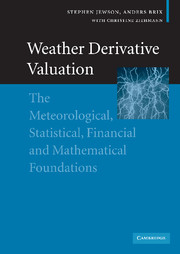 Weather Derivative Valuation
Weather Derivative Valuation Book contents
- Frontmatter
- Contents
- List of figures
- List of tables
- Acknowledgements
- 1 Weather derivatives and the weather derivatives market
- 2 Data cleaning and trends
- 3 The valuation of single contracts using burn analysis
- 4 The valuation of single contracts using index modelling
- 5 Further topics in the valuation of single contracts
- 6 The valuation of single contracts using daily modelling
- 7 Modelling portfolios
- 8 Managing portfolios
- 9 An introduction to meteorological forecasts
- 10 The use of meteorological forecasts in pricing
- 11 Arbitrage pricing models
- 12 Risk management
- 13 Modelling non-temperature data
- A Trend models
- B Parameter estimation
- C Goodness of fit tests
- D Expected pay-offs for normally distributed indices
- E Pay-off variances for normally distributed indices
- F Greeks for normally distributed indices
- G Exact solutions for the kernel density
- H The beta for a normally distributed index
- I Simulation methods
- J Efficient methods for pricing against a portfolio
- References
- Index
10 - The use of meteorological forecasts in pricing
Published online by Cambridge University Press: 22 September 2009
- Frontmatter
- Contents
- List of figures
- List of tables
- Acknowledgements
- 1 Weather derivatives and the weather derivatives market
- 2 Data cleaning and trends
- 3 The valuation of single contracts using burn analysis
- 4 The valuation of single contracts using index modelling
- 5 Further topics in the valuation of single contracts
- 6 The valuation of single contracts using daily modelling
- 7 Modelling portfolios
- 8 Managing portfolios
- 9 An introduction to meteorological forecasts
- 10 The use of meteorological forecasts in pricing
- 11 Arbitrage pricing models
- 12 Risk management
- 13 Modelling non-temperature data
- A Trend models
- B Parameter estimation
- C Goodness of fit tests
- D Expected pay-offs for normally distributed indices
- E Pay-off variances for normally distributed indices
- F Greeks for normally distributed indices
- G Exact solutions for the kernel density
- H The beta for a normally distributed index
- I Simulation methods
- J Efficient methods for pricing against a portfolio
- References
- Index
Summary
Chapters 2 to 8 have described methods for the actuarial pricing of weather derivatives when no meteorological forecasts are available. In practice, these methods are used when pricing well before the start of a contract. We will occasionally refer to values calculated in this way as par values. Relevant meteorological forecasts then start to become available around six months before the start of contracts in the United States and around three weeks before the start of contracts in Europe.
The availability of skilful forecasts changes the methods that one must use for the pricing of weather contracts. A skilful forecast means that the range of meteorological outcomes that are considered possible is reduced, and their probabilities changed. When the forecasts are weak this reduction is small, and when the forecasts are highly skilful this reduction is large.
The simplest case of forecast-based pricing is when a forecast is available that covers the whole remaining period of a contract. The contract can then be priced using the forecast alone. In many cases, however, the available forecasts will not cover the whole remaining period of the contract, and a mix of historical data and forecast must be made. As we will see below, making this mix in an accurate way is not always a trivial exercise.
Unfortunately for those involved in the development of algorithms to price weather derivatives, meteorologists tend to provide weather and seasonal forecasts separately, and in very different formats. Often they come from entirely different sources.
- Type
- Chapter
- Information
- Weather Derivative ValuationThe Meteorological, Statistical, Financial and Mathematical Foundations, pp. 220 - 240Publisher: Cambridge University PressPrint publication year: 2005


